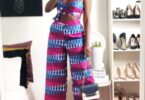It is everyone’s pride and pleasure to don an African fabric and print clothing when attending an occasion. Although most of us do not have any idea of the history of the African fabric, we all love the hand-made, bright-colored, idiosyncratically designed, and patterned African fabric clothing since it gives us a sense of rich cultural meaning.

Traditionally, different African fabric clothing was only worn for specific special occasions such as weddings, funerals, family reunions, and other events. Although these fabrics did not have any particular significance or importance attached to them, they created cultural identities and symbols of cultural heritage.
The variety of African fabric and their countries of origin are as follows.
Ankara

Ankara fabric which is also referred to as “African wax prints”, “Ankara prints”, “Dutch wax” or simply “African prints” is made of 100% cotton and is characterized by vibrant and colorful patterns.
Initially, Ankara was manufactured by the Dutch in Indonesia. However, the fabric gained more popularity in West African countries including Nigeria, Ghana (formerly Gold Coast), and Zambia due to its tribal-like patterns. A Dutch entrepreneur, Pieter Fentener Van Vlissingen, saw that there was a high demand for the printed fabric and, thus, introduced it with his company, Vlisco, to the West African countries where it became very popular.
Clothing associated with Ankara fabric include Ankara shirt, Ankara skirts, women African print dress Ankara, African print maxi skirt, African print maxi dress, African print unisex, Ankara African print, Ankara dress, head wraps, Ankara piece sets, wax prints among others.
Kitenge

Chitenge which is also referred to as Kitenge is an African wax print fabric mainly found in East Africa, West Africa, and Central Africa. It is the same with Sarong or Kangas and is mostly donned by women.
Chitenge can be wrapped around the waist or chest by women, or used and a headscarf or head wrap, and sometimes as a baby sling. Chitenge is also used in manufacturing Dashiki shirts for men and Dashiki blouses for women. Dashiki is a colorful clothing that covers the top half of the body. Dashiki is also known as Kitenge in East Africa.
Shweshwe

Shweshwe is a traditional South African printed and dyed cotton fabric. Traditionally, it was worn during weddings and family functions. Shweshwe was only made in three colors namely red, blue and brown. The fabric which has original navy dye is now being manufactured in many colors and printing designs with unique and sophisticated geometric patterns.
Kente

Kente refers to a Ghanaian brightly colored fabric that is dyed with various designs and patterns. The fabric was originally known as “nwetom” by the ethnic Akan of Ghana. It is a type of cotton and silk fabric manufactured by interweaving cloth strips.
The Kente cloth was first made in green and yellow colors but it has since adopted more colors and designs while maintaining the same Kente pattern. Besides Ghana, Cote d’Ivoire has also adopted the Kente print clothing.
Baoule

Baoule is a five-inch hand-woven strips of fabric originally made in Cote d’Ivoire. The fabric strips are first hand-woven and then sewn together to make a cloth. Baoule is very thick and heavy. The strips are used in the manufacture of African dresses for women, African shirts for men, shoes, hats, and bags.
Conclusion
Several African countries have adopted various unique fabrics and patterns to embody their cultures and identities. The varieties of fabrics play a significant role in promoting, protecting, and supporting African culture. Given the significance and evolution of these African fabrics, we should all be proud to wear the African print clothing each day and not only for particular occasions.









